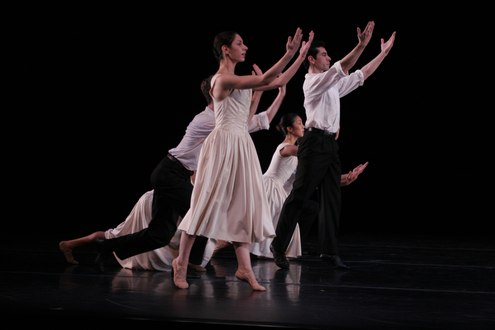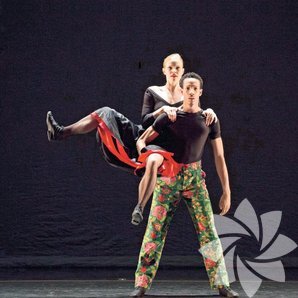As a fan of classical music and any high quality performance of fine arts, dance, and drama, I try to get a hold of a program booklet of İş Sanat as early as possible. Many names, such as Maxim Vengerov, are familiar. A few are not, but entice interest: the Limón Dance Company was one such name.
A brief visit to Google brought light into the name “Limón.” The Company derived its name from the internationally-heralded dancer Jose Limón, and carried his legacy into modern times. They were the first dance group to perform at the Lincoln Center for Performing Arts, among the most prestigious of performance halls and host of the Metropolitan Opera and the New York Philharmonic, they had won the National Medal of Arts of the USA, and even performed at the White House. Twice! I had made the right decision!
At the auditorium, we were greeted by sudden darkness, pitch black, and silence. It was so silent that it was possible to hear the rustle of the curtain as it was drawn. As the speakers started a gentle playback of Chopin’s famous Mazurkas, the dancers came in groups of two or three, a total of four women, saluting the audience and turning and twirling around to salute each other. The ladies were dressed simply in white cloths that reminded me of medieval underdresses. The men had on plain, earthly pants and simple, plain chemise, which again took me back to earlier centuries.

The Limón Dance Company performed only in dance, but it was a performance of drama, feeling, and aura. Their dance conveyed a story; a story of feeling, rhythm, energy, and the human experience. It also portrayed precision, harmony, perseverance, and immaculate rhythm. They were gentle but lithe, flowing but sprightly. At times they were innocent and fresh, at times grim and ominous. But, they were always the master of the movement and of the moment.
The first act featured ten Mazurkas, the mediaval form of slow, courtroom dance, as interpreted and composed by Chopin, and choreographed by the late Jose Limón. The program booklet provided not only the title (Opus no.) of each Mazurka, but indicated also the name of the particular dancer performing the piece. An appreciation of the artist. The premiere Mazurka was the Opus 68, No. 1 in C major, and featured the entire ensemble. The second piece, Opus 41, no.1 was performed by Elise Drew Leon and Daneil Fetecua Soto…and so it went.
Each Mazurka had a flavor of its own and depicted a different performer(s). In Opus 56/1, Alter, Leon, Kruger and Monroe-Cook danced in a way that mirrored a Mediaval dance party. Only the most hopeful, joyful, and innocent of feelings were present as they twirled around in their white dresses. Chopin’s Opus 17, No. 4 featured Daniel Soto, who was in the search of something, something for which he yearned. But he also carried out this search of solitude with pride and determination. He ran towards it sometimes and seemed to capture it, but it fluttered again out of his hands. From where I stood, I could hear his heavy breathing, a manifestation of the arduousness of performance, and adding to the drama of the dance
In Opus 30, No. 4, featuring Monroe-Cook and Ruvalcaba, the music and spirit were joyful and sprightly again, with Chopin’s music gentle in the background. The male and female figures were taking part in a vivacious, sprightly dance, with nuances of flamenco and the pasodoble. In the final Mazurka, the Opus 30, No. 3, featuring the entire ensemble, the notes of the keyboard were personified in the dancers: the female dancers frolicked in the higher, sprightly notes, while the lower, bass keys had the male dancers turning and limbering around.
The first half was gentle, yet full of energy. It provided a mood of ease and pleasure, yet was precise and limber. It was innocent, yet not simple. And the applause was appreciative and enthusiastic.

However, if the first performance was gentle and innocent, the second performance was anything but. Titled “The Moor’s Pavane,” it featured the composition Pavane (named after the Renaissance dance) of the seventeenth century composer Henry Purcell, a piece dating back some four hundred years. “The Moor” was Shakespeare’s Othello, and the dance narrated the story of Othello, his ill-fated wife Desdomana, the antagonist Iago, and his unsuspecting wife Emilia. The music and the story were old, but the human experience was timeless. So was the dance, again choreographed by Jose Limón.
If the previous dance conveyed innocence, hope, and sprightly spirit, this one had deceit, cunning, plotting, and scheming. It had manipulation, suspense, and slander; it showed the destruction of the ill-fated innocence. The lively gait of the previous act was replaced by ominous music, the choreography included choking. At the end of the act, all but Iago lay dead on the stage, and the audience was left in morbid horror. But the dance was always elegant, and the artistry ever-present and impeccable. The Limón Dance Company was lithe, flamboyant, precise, and masters of movement. The curtain drew back, and as each dancer to a bow, we all took sighs of relief that our heroes and heroines were still alive.
In the third and final act, the Limón Dance Company came in with a totally different choreography, mood, and costume. The music featured was of Paquito D’Rivera, the multiple Grammy-award winning Cuban alto and soprano saxophonist and clarinetist. The choreography came from Rodrigo Pederneiras, a contemporary name well known and heralded in his field.
This time, the dancers were merry, in both costume and movement. The male dancers had on white pants with high waistlines and orange, green, red, blue imprints of flowers. The female dancers wore white dresses with matchingly colorful hems. The ladies skidded, hopped, glided, twisted, twirled, while the gentlemen moved in bouncy strides. At times, they reminded me of winding dolls, moving with precise but jerky movements. The lights dimmed, and they danced one on one with moves that blended the acrobatic with slow ballroom turns, swirls, and glides. Synchronization was key. The movements were merry but articulate and precise. The music blended bossa nova, lounge, African and Arabic drums and rhythm, with sprinkles of the violin, clarinet, and flute.

As the Limón Dance Company presented their final dance to us and took a bow, we applauded and left the stage having witnessed myriad dance forms and mood. Yet, every single movement, step, and form of the evening was done with precision, mastery, great artistry. Jose Limón would have been proud.










